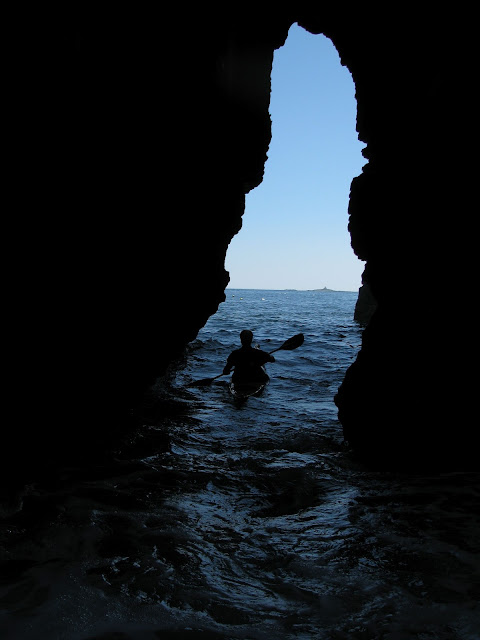Then, since it was windy, we paddled over to Hatch Cove and found some placid water to refine strokes. Peter, who is already an ACA - certified instructor, came along to help-out. He'll be joining the instructor line-up at Old Quarry. Given the windiness "outside," Hatch Cove was amazingly calm. It's satisfying to follow a hunch and find the right conditions. We followed the granite contours of shore at high tide, working on boat handling skills, but also just enjoying the place.
Teaching has been going well. Captain Bill says we've been getting more requests for instruction than ever before. I've been enjoying it, and I think our students have as well. Beginners are often surprised at how much they can do on their first day paddling: edging, bracing, wet exits and rescues- skills that took me a long time to try when I first started. Everyone learns differently, and most people don't know what there is to know, but the concepts that define skills as "beginner" or "advanced" are pretty sketchy. People start creating habits as soon as they get in the boat. Some habits are better than others. If you can turn your boat by edging and learn a brace your first day out, why not? We can teach rolling to people who have never paddled before. (Not that they'll learn it right away). Advanced skill? I don't know- just a good skill.
While we were contour paddling in Hatch Cove, a different scene unfolded near Camp Island. My account is a little different than the newspaper's, but I'm grateful that they gave me credit for my small part of the drama. A schooner ran aground on a ledge after its rudder was fouled by fishing gear. Bill, who'd heard the distress call on the radio, arrived in the Nigh Duck as the passengers were evacuated to Camp Island. Bill brought a couple crew members back to Old Quarry to pick-up timbers to shore-up the hull as the tide went out. I was just returning from teaching, still in Hydroskins and a semi-dry top, so I was a natural appointee to go into the water. I paddled out to the Nigh Duck and we hoisted my kayak aboard. Off we went.
I spent about a half-hour in the water, placing timbers beneath the hull. After one of their crew members put on a tank and a wetsuit, I pushed him down so he could get the buoyant timber wedged further beneath the hull. Then I swam back to the Nigh Duck. The water was 62 degrees- warmer than usual, but by then I was a bit chilled. Bill pulled me back aboard and gave me a lift back to Stonington, where I had under an hour to ready the gallery for the evening artist's talk.
That's how summer goes. We keep busier than we would like, but it keeps things interesting. Most of my paddling is for work, but it's still paddling. And teaching is a great way to hone personal skills. When a tandem capsized on a guided trip a couple weeks ago, Nate and I had the paddlers back in their boat in no time- the result of repeated practice.




























